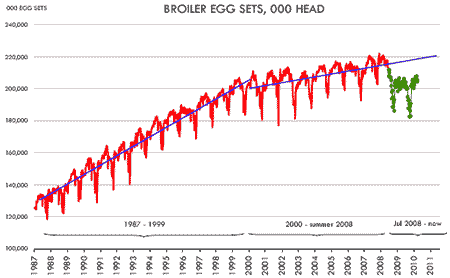



CME: Drop in US Broiler Output Impacts All Meats
US - The reduction in US broiler output has had an impact on the whole meat industry and it is partly responsible for the suddenly hot meat protein market this spring, write Steve Meyer and Len Steiner.USDA released on 7 April the results of its weekly survey of broiler hatcheries in 19 selected states and overall the report continued to show that the industry has little appetite for expansion, with egg sets near year ago levels. The report showed that for the week ending 3 April commercial hatcheries in the 19 surveyed states set 204.322 million eggs in incubators, just 0.3 per cent above year ago levels.
Those that follow these numbers closely – which is just about everybody in the broiler industry but also many in the livestock sector – likely noticed a blimp in the year over year increase of egg sets during March. The March egg set weekly average was up 2.5 per cent compared to the previous year, the biggest year over year increase for a given month since early 2008. While the increase was notable, it was mostly due to a dip in egg sets last March rather than a new found impetus for expansion by broiler producers in 2010. Indeed, weekly egg sets have been quite steady in recent weeks and they remain well below five year average levels. Overall the report indicates that US broiler supplies in Q2 will be close to year ago levels.
For livestock producers, the situation in the broiler industry is important. Broiler production accounts for the largest component of meat consumption in the US and the scale of the industry is such that small changes can contribute significant pounds to the weekly protein available in the market-place. While looking at the week to week change is important in assessing short term market factors, it is often instructive to take a step back and look at the big picture. When thinking about a graphic to illustrate our point in today's letter, we decided to replace the usual year/year comparison chart with one that showed the actual weekly level of US broiler egg sets since the survey started back in 1987.

In the course of 20+ years, we can see two significant shifts in the industry. The rapid growth of the late 1980s and 1990s came to an end with the collapse of the tech bubble and the resulting US recession in the early 2000s. Since then, the industry continued to growth but at a much smaller pace.
Then came the financial crisis in the summer of 2008, which resulted in the bankruptcy of Pilgrim's Pride, the largest US broiler producer. In the past, producers had reduced egg sets and chick placements in response to market conditions but those cut-backs were often temporary. The financial crisis led to closures of hatcheries and plants, which reverberated along the well integrated supply chain.
Today, the industry finds itself smaller than it was back in 2008. Current egg sets of around 205 million per week are about seven per cent below what the pre-financial crisis trend for this decade would suggest. US unemployment levels are much higher than what they were before the crisis and there is plenty of excess capacity in the food-service sector.
However, the reduction in broiler pounds has had an impact not just on that industry but the meat complex as a whole and it is partly responsible for the suddenly hot meat protein market this spring.











